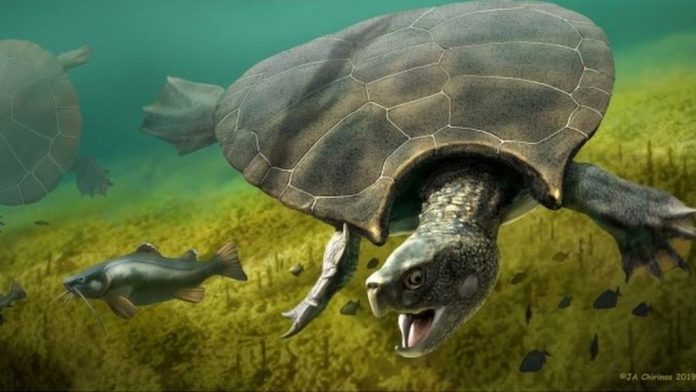Researchers of the University of Zurich (UZH) and fellow researchers from Colombia, Venezuela, and Brazil have now reported exceptional specimens of the extinct turtle recently found in new locations across Venezuela and Colombia. “The carapace of some Stupendemys individuals reached almost three meters, making it one of the largest, if not the largest turtle that ever existed,” says Marcelo Sánchez, director of the Paleontological Institute and Museum of UZH and head of the study. The turtle had an estimated body mass of 1,145 kg — almost one hundred times that of its closest living relative, the big-headed Amazon river turtle.
Males carried horns on their carapace
In some individuals, the complete carapace showed a peculiar and unexpected feature: horns. “The two shell types indicate that two sexes of Stupendemys existed — males with horned shells, and females with hornless shells,” concludes Sánchez. According to the paleobiologist, this is the first time that sexual dimorphism in the form of horned shells has been reported for any of the side-necked turtles, one of the two major groups of turtles world-wide.
Despite its tremendous size, the turtle had natural enemies. In many areas, the occurrence of Stupendemys coincides with Purussaurus, the largest caimans. This was most likely a predator of the giant turtle, given not only its size and dietary preferences, but also as inferred by bite marks and punctured bones in fossil carapaces of Stupendemys.
Turtle phylogeny thoroughly revised
Since the scientists also discovered jaws and other skeleton parts of Stupendemys, they were able to thoroughly revise the evolutionary relationships of this species within the turtle tree of life. “Based on studies of the turtle anatomy, we now know that some living turtles from the Amazon region are the closest living relatives,” says Sánchez. Furthermore, the new discoveries and the investigation of existing fossils from Brazil, Colombia and Venezuela indicate a much wider geographic distribution of Stupendemys than previously assumed. The animal lived across the whole of the northern part of South America.








